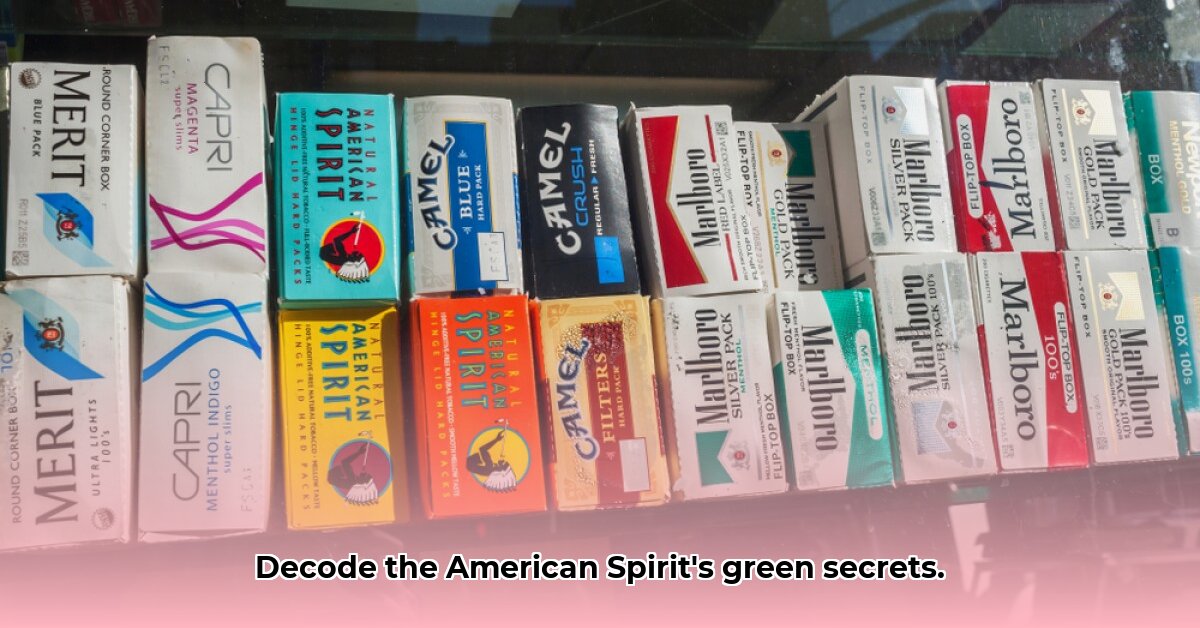American Spirit cigarettes are marketed for their natural, additive-free tobacco. However, the color-coded packs can be confusing. This comprehensive guide clarifies the meaning behind the colors, addresses inconsistencies, and helps you make informed choices. Learn how to navigate this system and find the information you need. For a quick color guide, check out this helpful resource: American Spirit color guide.
American Spirit’s Green Initiatives: Unveiling the Color Code
American Spirit cigarettes are known for their claim of using organic tobacco and being additive-free. The color-coded packaging, intended to guide smokers, often leads to confusion. Let’s examine American Spirit’s branding and discover how to choose the right American Spirit blend based on available information.
Decoding the Rainbow: Demystifying the Colors
American Spirit utilizes color to differentiate its cigarette varieties. Generally, lighter shades suggest lower nicotine levels and milder flavors, while darker colors indicate stronger cigarettes with bolder tastes. However, information online often varies, leading to consumer uncertainty. What is the general consensus on nicotine levels in American Spirit cigarettes based on color?
The concept of color-coding is useful, but inconsistent information about nicotine content and taste profiles creates a challenge. This inconsistency can be frustrating for consumers. How can American Spirit improve its communication regarding color-coded blends?
The Color Challenge: Addressing the System’s Shortcomings
The lack of universally consistent information regarding American Spirit’s products is a significant issue. Relying solely on color provides a general indication, but accuracy is not guaranteed. How can American Spirit make its branding more effective and transparent?
Here’s a breakdown of what is generally understood, along with the limitations:
- American Spirit uses colors to distinguish its products, with lighter colors often associated with lower nicotine and milder flavors.
- Precise nicotine levels for each color vary depending on the source of information.
- Flavor descriptions are subjective, making them difficult to standardize and potentially unreliable for decision-making.
Informed Choices: Tips for Consumers
Given the potential for confusion, what steps should a smoker take?
- Consult Multiple Sources: Compare reported nicotine levels and flavor profiles from various online sources to gain a broader understanding, while remaining skeptical.
- Keep Expectations Realistic: Recognize that the color-coding system provides a general estimate rather than a precise measurement.
- Contact the Manufacturer: Reach out to American Spirit directly for clarification or more detailed product information.
Actions for Transparency: Recommendations for American Spirit and Regulatory Bodies
Clear and accessible information is the responsibility of both the company and regulatory agencies.
Recommendations for American Spirit:
- Provide Detailed Product Information: Offer verifiable data on nicotine and tar content, as well as comprehensive ingredient lists, through official websites and packaging.
- Refine Flavor Descriptions: Conduct sensory testing with trained professionals to develop objective flavor descriptions for each blend.
- Gather Consumer Feedback: Conduct surveys or focus groups to understand how consumers interpret the current color-coding system and identify areas for improvement.
Recommendations for Regulatory Bodies (e.g., the FDA):
- Strengthen Marketing Regulations: Enforce stricter guidelines on marketing claims related to nicotine content and potential health effects.
- Mandate Clear Labeling: Require uniform reporting of nicotine and tar levels directly on cigarette packaging.
- Address Misinformation: Implement strategies to monitor and regulate online platforms to prevent the spread of inaccurate information about tobacco products.
Assessing the Risks: Clarity and Consumer Safety
Inconsistent information about American Spirit’s products poses certain risks.
| Risk Category | Severity | Likelihood | Potential Impact | Mitigation Strategies |
|---|---|---|---|---|
| Inconsistent Nicotine Info | High | High | Consumer misunderstanding of nicotine intake; potential health consequences due to inaccurate dosage estimations. | Standardized reporting; increased regulatory oversight; independent verification; prominent health warnings; accessible educational resources. |
| Misleading Flavor Claims | Medium | Medium | Consumer disappointment; inaccurate perception of product characteristics. | Clearer labeling; impartial flavor profile verification; consumer education campaigns; transparent disclosure of ingredients. |
| Online Misinformation | Medium | High | Consumer deception; potential adoption of harmful health behaviors based on false or misleading information. | Regulatory action against false claims; proactive consumer education; fact-checking initiatives; collaboration with online platforms to address misinformation. |
Greater transparency benefits consumers, American Spirit, and regulatory bodies. Moving forward requires a commitment to accuracy and truth. Why is transparency crucial in the marketing and regulation of tobacco products?
Understanding American Spirit Cigarette Color Codes for Nicotine Strength
American Spirit’s color codes are intended to communicate nicotine levels and flavors. While some sources provide nicotine information, it often varies. The brand emphasizes the use of organic and additive-free tobacco. Let’s examine American Spirit nicotine levels by color and available data.
Decoding Colors: A Guide to Estimated Nicotine Levels
American Spirit cigarettes employ a color-coded system. Determining how to interpret American Spirit cigarette color codes for nicotine strength can be challenging due to a lack of standardized information. Different websites present varying nicotine levels for the same color. How can consumers effectively use the available information to understand American Spirit’s color guide?
Lighter colors (yellow, orange) are generally associated with lower nicotine concentrations, while darker colors (blue, black) suggest higher levels. The color’s intensity often correlates with the nicotine strength. However, this is not precise.
The Inconsistency Issue
Nicotine content per cigarette, even within the same color category, is not consistently reported. This may be due to variations in tobacco batches, manufacturing processes, or testing methodologies. What factors contribute to the difficulty in regulating nicotine levels in tobacco products?
Beyond Nicotine: Flavor Profiles
In addition to nicotine content, colors indicate different flavor profiles. Yellow may suggest a light and smooth flavor, while black might indicate a more robust and intense flavor. Some varieties include added flavorings, such as spearmint (in green packs) or guarana (in orange packs). However, complete ingredient lists are not always readily available. What are some alternative companies in the tobacco industry that prioritize transparency in their labeling practices?
Recommendations for Consumers
- Approach Information Critically: Refrain from fully trusting online sources that provide specific nicotine levels without verifiable data.
- Recognize General Trends: Understand that darker colors generally signify stronger cigarettes.
- Consult Reviews and Ratings: Seek out online reviews to gather insights regarding the strength and taste profiles of different color packs.
- Seek Advice From Retailers: Engage with knowledgeable store employees who can provide guidance.
- Prioritize Health and Wellness: Remember that smoking carries inherent health risks, irrespective of the brand or nicotine level.
Conclusion: Exercise Prudence
American Spirit’s color-coding system offers a general indication of nicotine strength and flavor profiles. Inconsistencies in reported nicotine levels warrant caution. Consumers should interpret the system as a broad guideline rather than a precise measurement. What are ethical considerations for retailers when discussing health risks associated with tobacco products?
American Spirit Cigarette Color Variations: Exploring Regional Differences and Consumer Perceptions
American Spirit’s color-coded packaging signifies distinct tobacco blends, each possessing unique flavor profiles and nicotine strengths. Inconsistencies in reported levels exist. The brand’s emphasis on “natural” and additive-free tobacco does not negate the inherent health risks associated with smoking.
Unveiling the Color Code: Decoding the Meanings
American Spirit’s color-coded system is a hallmark of its branding, raising the question: How effective is American Spirit’s branding in accurately conveying product information? Each color represents variations in flavor and nicotine strength. Yellow typically denotes milder blends, while darker shades (black, red) suggest bolder flavors and higher nicotine. Green often indicates organically grown tobacco. However, the precise nicotine and tar content fluctuates. What are the primary marketing strategies employed by tobacco companies to attract and retain customers?
Variations in nicotine and tar content raise concerns. Does a lack of standardization hinder consumers’ ability to make informed decisions?
Addressing the Inconsistencies: Navigating Regional Differences
Websites offer “guides” to American Spirit’s color codes, yet their data often conflicts. Discrepancies in reported nicotine and tar levels exist. What are the most reliable sources for accurate and up-to-date information regarding tobacco product content?
Examining the “Natural” Claim: A Critical Perspective
American Spirit promotes its cigarettes as “natural” and additive-free. However, it’s crucial to understand that “natural” does not equate to “safe.” All tobacco products pose health risks. Should stricter regulations be implemented to govern the use of “natural” claims in product branding, particularly for items with known health risks?
Advocating Transparency and Standardized Testing
The absence of standardized testing impedes both consumers and researchers. Independent verification of nicotine and tar levels is crucial. Until uniform and reliable data becomes available, comparisons of different American Spirit variations will remain challenging. This is critical for understanding the impact of blends on health. Who bears the primary responsibility for addressing health risks associated with tobacco consumption?
A Call to Action: Advancing a More Transparent Future
Consumers require clear and accurate information. American Spirit should prioritize standardized testing and ensure that labeling accurately reflects nicotine content. Public health officials must advocate for stricter regulations and independent researchers should conduct studies on the
- Shop Bento Box for Sale To Find Your Ideal Lunch Container - December 6, 2025
- Lunch Box That Fits Bento Box Neatly for Daily Use - December 5, 2025
- Japanese Lunch Bag Does Double Duty as Bento Carrier and Tote - December 4, 2025










